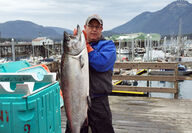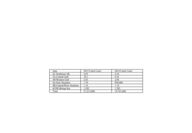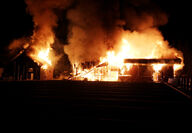Sorted by date Results 301 - 325 of 378
Five of Alaska Marine Highway System’s 11 ferries will be laid up at some point next year under a draft vessel deployment plan released on June 24. The Taku will be held in layup status the whole year, while the Kennicott will be from October until entering overhaul in early January. The Fairweather and Chenega will enter federal projects in October and mid-September, respectively, and will both be laid up starting in May 2016. The Malaspina is also scheduled to enter layup status in late May of next year. Under the draft schedule, from O...
WRANGELL — The Red Chris mine in neighboring British Columbia passed its final bureaucratic hurdle, after the province’s Ministry of Energy and Mines issued a Mines Act permit amendment last Friday. The mine’s owning company, Imperial Metals, had earlier been granted its Environmental Management Act Permit on June 15, allowing Red Chris to begin discharging tailings into its tailings storage facility. From there, water can be discharged subject to provincial water quality guidelines. The Red Chris property is located in the province’s northwe...
As Alaska’s salmon season heads into high gear, a few bright spots are surfacing in an otherwise bleak global sales market. Sales and prices for all salmon (especially sockeye) have been in a slump all year. And amidst an overall glut of wild and farmed fish, Alaska is poised for another huge salmon haul, with the largest run of sockeye salmon in 20 years predicted along with a mega-pack of pinks. Meanwhile, the single toughest thing stacked against Alaska’s sales to traditional overseas customers is the strong US dollar. “Overall, the dolla...

He was alone on his boat, and it was a bit of a battle. Scott Stafford, of Petersburg, caught his Salmon Derby winning 50.9 pound fish on Saturday. Fishing from his 22-foot-long Alice Marie, just outside of the North Arm with fishermen from a dozen vessels watching nearby, Stafford said it took about 30 to 40 minutes to reel in the fish. The fisherman brought the king salmon up to his boat about seven times. It went under the boat, around the boat. Finally he got it to where the head was... Full story

Not common for the area, a short-lived thunderstorm caused a minor disturbance in Petersburg on Tuesday. At about 3:10 p.m., a lightning strike hit a tree, transformer line and transformer, putting "the whole island in the dark," Petersburg Municipal Power and Light Superintendent Joe Nelson said. "The tree was kind of hurt bad, the transformer line is OK, the transformer was destroyed and had to be replaced," he added. That work took about an hour and a half before power was back on. The transf...
If you spend lots of time out on the water, you may, sooner than later, be seeing dolphins and porpoises you wouldn’t normally see this far north. Marine Mammal Specialist Kate Wynne, with the Alaska Sea Grant Marine Advisory Program, went over common and upcoming cetacean species in Southeast Alaskan waters during the Petersburg Science Series Tuesday evening at the Public Library, speaking to a crowd of about 15. “Things are changing so much out in the ocean that I want to get you alerted to the fact that there are these other species tha...
It’s been a concern since budget talks began: the Alaska Marine Highway System’s summer ferry service will remain as scheduled — with the exception of the MV Taku. That ferry won’t be returning until October as maintenance to other vessels has delayed its annual overhaul, according to Alaska Department of Transportation and Public Facilities. The MV Taku was originally slated to begin sailing again in July. With the Taku out, sailings to and from Prince Rupert, British Columbia, will be cut from four to two trips a week. Those include stops in... Full story
JUNEAU (AP) — Alaska has clear interests in protecting with extreme vigilance the water quality in rivers that flow into the state that could be affected by mine projects across the border in Canada, Lt. Gov. Byron Mallott said Monday. Mallott, who leads a working group for Gov. Bill Walker’s administration focused on trans-boundary waters, spoke with reporters by phone about a fact-finding and relationship-building trip to British Columbia last week. Mallott said the trip included the start of discussions looking at ways to strengthen the sta...
Alaskan salmon producers are not buying the presumption that growing numbers of pinks are eating too much food in the ocean, causing sockeye salmon to grow slower and smaller. That’s the claim of a new study by Seattle and British Columbia researchers, who say the race for food ultimately affects sockeye abundance and survival. “Our data sets extend up to 55 years each. In terms of looking at productivity or survival of salmon, they’ve included 36 sockeye populations,” said Greg Ruggerone, a researcher at Natural Resources Consultants in Seat...
Caribou instead of corn dogs…salmon instead of Trout Treasures… seal meat in place of spaghetti – all could soon be available to more Alaskans if traction continues on a new bipartisan bill before the Alaska legislature. The bill - HB 179 - allows schools, senior centers, hospitals, child care centers and other facilities to accept and serve fish, game, plants and eggs that are donated by subsistence and sport users. Currently, well-meaning state laws intended to prevent the commercial sale of wild game make the practice illegal if a progr...

The Inside Passage Waterkeeper organization premiered their "Water is Life" film to a Petersburg audience of about 50 at the public library on Friday. The ten-minute video follows the Stikine River from its headwaters to its terminus and highlights its importance to nearby communities. "The purpose of the video is to help people remember that this really is a rich, rich resource that we have here and it's increasingly rare in this world to have such a rich resource like that," said Daven Hafey,...
JUNEAU (AP) — U.S. Rep. Don Young has introduced legislation that would provide federal recognition for states that allow medical marijuana. According to a press release from Young's office, the legislation, also sponsored by Democratic Rep. Steve Cohen of Tennessee, would prevent federal prosecution of medical marijuana patients, doctors and businesses in states that allow medical marijuana. It would also allow Veterans Administration doctors to recommend medical marijuana to their patients. The bill matches one introduced in the Senate e...
JUNEAU (AP) — Alaska’s minimum wage will rise to $8.75 an hour Tuesday, giving a pay increase to thousands of workers. Voters in November overwhelmingly approved raising the minimum wage from $7.75 per hour to $8.75 per hour, effective Jan. 1. Because the state constitution calls for ballot measures to take effect 90 days after election results are certified, the raise doesn’t take effect until Tuesday. A second increase, to $9.75 per hour, is scheduled to take effect Jan. 1 under the initiative. The minimum wage is to be adjusted for infla...
Last year was one of the busiest years ever for Alaska brokers who help fishermen buy, sell and trade fishing permits and quota shares. “I was really happy to see such a good mix of permits we were selling – it wasn’t just one thing,” said Olivia Olsen of Alaskan Quota and Permits in Petersburg. “We had a lot of Dungeness crab permits, charter halibut permits, salmon and shrimp permits, sea cucumbers, and then whatever IFQs we could find.” Salmon permit sales peak from March through May, and early indicators point to lower salmon prices this...
JUNEAU (AP) — The state transportation department is proposing reductions in ferry service as part of an effort to cut costs. The changes proposed for the next fiscal year include pushing back the start of service by the Taku between Prince Rupert, British Columbia, and Juneau; and reducing service to Prince Rupert in the summer. Mainliner service to Sitka and southeast Alaska communities also would be reduced, the department said. The Malaspina would not run as a day boat in north Lynn Canal between July and September under the proposal. I...
JUNEAU (AP) — Fisher-men in Alaska will have access to slightly more halibut this year than last. The International Pacific Halibut Commission voted Friday in Vancouver, British Columbia, for a total catch in Alaska of 21.215 million pounds, up from 19.705 million pounds in 2014. That's the first time in a decade the commission has increased the catch. The six-member panel meets annually to set the halibut catch limits from Northern California to the Bering Sea. There are three commissioners from the U.S. and three from Canada. The Alaska c...

Freezer displays at Walmart superstores in Alaska and Washington now include a new lineup of 14 Alaska seafood items. The world's largest grocer announced the expanded commitment to Alaska seafood last week. "We are so proud to bring these to our customers, and we also know how important it is to local fishermen and folks across the state," said John Forrest Ales, Director of Corporate Communications for Walmart. Company stores already carry Alaska halibut and sockeye salmon. Added to the mix...
Alaska seafood marketers are facing some strong headwinds heading into 2015, notably, for sockeye salmon and crab. Snow crab is Alaska’s largest crab fishery, underway now in the Bering Sea. The fleet has a slightly increased 61 million pound catch quota; boats also are tapping on a hefty bairdi Tanner crab catch, the larger cousin of snow crab. A 25% increase in snow crab, the unexpected 15 million pound Tanner fishery, a weak Japanese yen, plus several million pounds of Russian snow crab from a new fishery in the Barents Sea, (not to mention...
Alaska still has its share of naysayers who will quibble about the seafood industry’s importance to our great state. They dismiss the fact that fishing was Alaska’s first industry and was fish that spawned the push to statehood. “The canned salmon plants started in the 1870s and by the early 20th century, canned salmon was the largest industry and generated 80% of the territorial tax revenues. It had a position in the state economy that oil enjoys today,” said fisheries historian Bob King. The fisheries that Alaska inherited from the federal...

January More than 600 Petersburg residents signed up for the borough's recycling program. The Petersburg Land Selection Committee requested the borough pursue legislative action regarding the State's calculation of land entitlement for the Petersburg Borough after the committee's determination that the State's selection of land was inadequate. The Petersburg School Board approved a $2.3 million exterior wall renovation project for the Rae C. Stedman Elementary School. Petersburg School District... Full story
The Pacific halibut stock appears to be rising from the ashes and that bodes well for catches in some fishing regions next year. It would turn the tide of a decades-long decline that has caused halibut catches to be slashed by more than 70% in Alaska, Washington, Oregon and British Columbia. Three Alaska areas showed improvement in the annual stock surveys that range from Oregon to the Bering Sea, and could have higher catch levels in 2015. That’s according to information revealed at the International Pacific Halibut Commission’s interim mee...
ANCHORAGE, Alaska (AP) _ The world's most acidic ocean waters are found during the cold winter months in the Bering Sea, according to a new study. Researchers at Columbia University released a series of maps tracking changes in global marine activity, The Alaska Dispatch News reported The new maps, based on 40 years' worth of measurements, show how acidity in marine waters around the globe changes with the seasons. The Bering Sea has shallow waters, a broad continental shelf and ocean currents that deposit nutrients from around the world....
The Petersburg Vessel Owners Association hosted a presentation by the International Pacific Halibut Commission (IPHC) exploring long-term halibut trends. IPHC Executive Director Bruce Leaman and quantitative scientist Ian Stewart presented the findings and fielding questions from the audience. The data collected look at halibut stocks from across the Pacific, from Alaska to British Columbia, Canada and south to Washington and Oregon. Stewart said that the IPHC has 100 years worth of data on the Pacific stock of halibut, which help IPHC to exami...
Throughout history, arguments over land and water usages have run the gamut from tussles over fences with next door neighbors to shoot outs over inter-state grazing rights in the old west, but when land and water rights pit one country against another, that’s when things really get tricky. That is the situation in Southeast Alaska, where residents find themselves downstream from several massive open pit gold/copper mines being developed in bordering British Columbia. The mines are located in the headwaters of some of Southeast’s largest and...
A few issues sparked a lively discussion among assembly members and the public at Monday’s regular meeting. Four residents spoke out against the use of herbicides and pesticides to be sprayed by the state in the area. The assembly discussed the issue and then voted to draft an ordinance that would take a position on spraying in the Borough. It will be modeled after a similar ordinance from the community of Skagway. Mayor Mark Jensen said that he’s still working to secure a date for a public community meeting regarding state regulations on the...